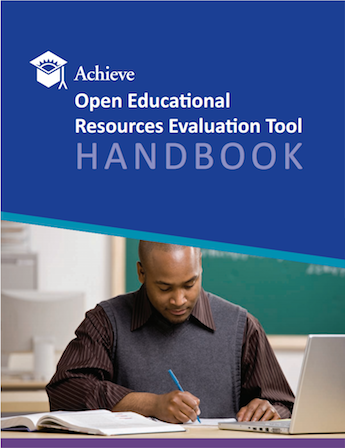Open Educational Resources (OER): Selecting Resources
Selection and Evaluation of OER Materials

Like any other materials you use in the classroom, OER materials need to be selected thoughtfully. Before you begin to search for textbooks or other learning resources, it's a good idea to have in mind some criteria for making selections. It makes the process of reviewing your results easier, and enables you to narrow down the possibilities more effectively.
Six major areas to consider are:
- Suitability
- Quality
- Accessibility
- Usability
- Licensing considerations
- Sustainability
Choosing OER materials wisely is a time-consuming process, but not really any different from selecting commericially published textbooks and other resources.
Tagcloud: Recognition of OER-based Learning, by UNU-ViE, used under a CC-BY SA license.
Selection Criteria: Overview
There are many ways of thinking about how to select classroom materials. On this page, you will find links to many tools that can help you with the process. Here are some ideas that can help you get started.
Suitability
Suitability has to do with how well the material matches up with your course and your students. Some key questions would be:
- Does the resource cover the material planned for the course?
- Is it comprehensive, or would it require supplemental resources? Which do you prefer?
- Is it pitched to the level at which the course is taught?
- Is the material organized in a way that suits your teaching style?
- Are the learning experiences well designed? Do they encourage deep learning?
- Is the material current, and is that important?
- Is the material culturally sensitive in its presentation?
Quality
Open access publishing breaks down many barriers to using and sharing information, but by its very nature, it has fewer gatekeepers. This means that the quality of the resources available can be uneven, and instructors need to exercise vigilance when selecting classroom materials.OER textbooks may not pass through the hands of professional editors and fact-checkers, as commercially published textbooks do. It is especially important to be aware that textbook sites that claim their material is 'peer reviewed' may be using quite a different process than is generally understood in the scholarly community (unlike open access journals, which adhere to the acknowledged standard). Here are a few key questions to consider:
- Accuracy: Are there factual errors that have not been corrected? Does the material reflect recent scholarship?
- Readability: Do the spelling, grammar, and punctuation meet your standards? Is the language clear, and are the explanations enlightening?
- Authority: Who is the author, and what are his/her credentials? If the material has been reviewed, who are the reviewers, and what are their credentials? Is the material published/endorsed by an organization? If so, what is the organization's reputation?
- Production: Are the physical qualities of the text, like headings, fonts, images etc., clear and usable? Do interactive components work? If there are linked resources, are the links functional? Do media components work, and are the sound and image quality acceptable? Does media stream or download well under ordinary internet conditions?
- Bias: Does the content display signs of bias, either in a social context, or in relation to the subject matter? How was the creation of the material funded/supported? Are there hidden agendas or conflicts of interest?
Accessibility and Inclusiveness
- Does the resource meet Atlantic Cape's standards for ADA compliance?
- Where appropriate to the subject matter, does the content reflect multiple voices and perspectives?
Usability
- Are there technological issues that would place obstacles in the path of students taking the course? Does the material require technology that is very old, very new, or expensive? Does it require more bandwidth than can reasonably be expected to be available where the students will be working?
Licensing
- Does the license attached to the material match with the way you intend to use it?
Sustainability
- How robust is the support system for the material? OER resources can go 'out of print' just as commercially published materials do. For essential teaching materials that will be used over the course of a whole semester, make sure that the resource can be downloaded by you and your students, and that the licensing agreement allows you to share your copy, in the event that the original is taken off-line.
Tools for Selecting OER
Accessibility Resources
 Accessibility Toolkit, 2nd ed. by Call Number: OnlineISBN: 9781774200292Publication Date: 2018The goal of the Accessibility Toolkit – 2nd Edition is to provide resources for each content creator, instructional designer, educational technologist, librarian, administrator, and teaching assistant to create a truly open textbook—one that is free and accessible for all students.
Accessibility Toolkit, 2nd ed. by Call Number: OnlineISBN: 9781774200292Publication Date: 2018The goal of the Accessibility Toolkit – 2nd Edition is to provide resources for each content creator, instructional designer, educational technologist, librarian, administrator, and teaching assistant to create a truly open textbook—one that is free and accessible for all students.
- Alt Text TesterThis free Google Chrome plugin checks images for alt-text tags. It frames images with tags in blue, and images without tags in red. To continue editing the page, you MUST reload it, so take note of which images you need to edit.
Credits
This guide was developed by Leslie Murtha, Robert Mast, Amanda Carey, Janet Hauge, and Mike Sargente, Atlantic Cape Community College Libraries.
Published June 2020.













